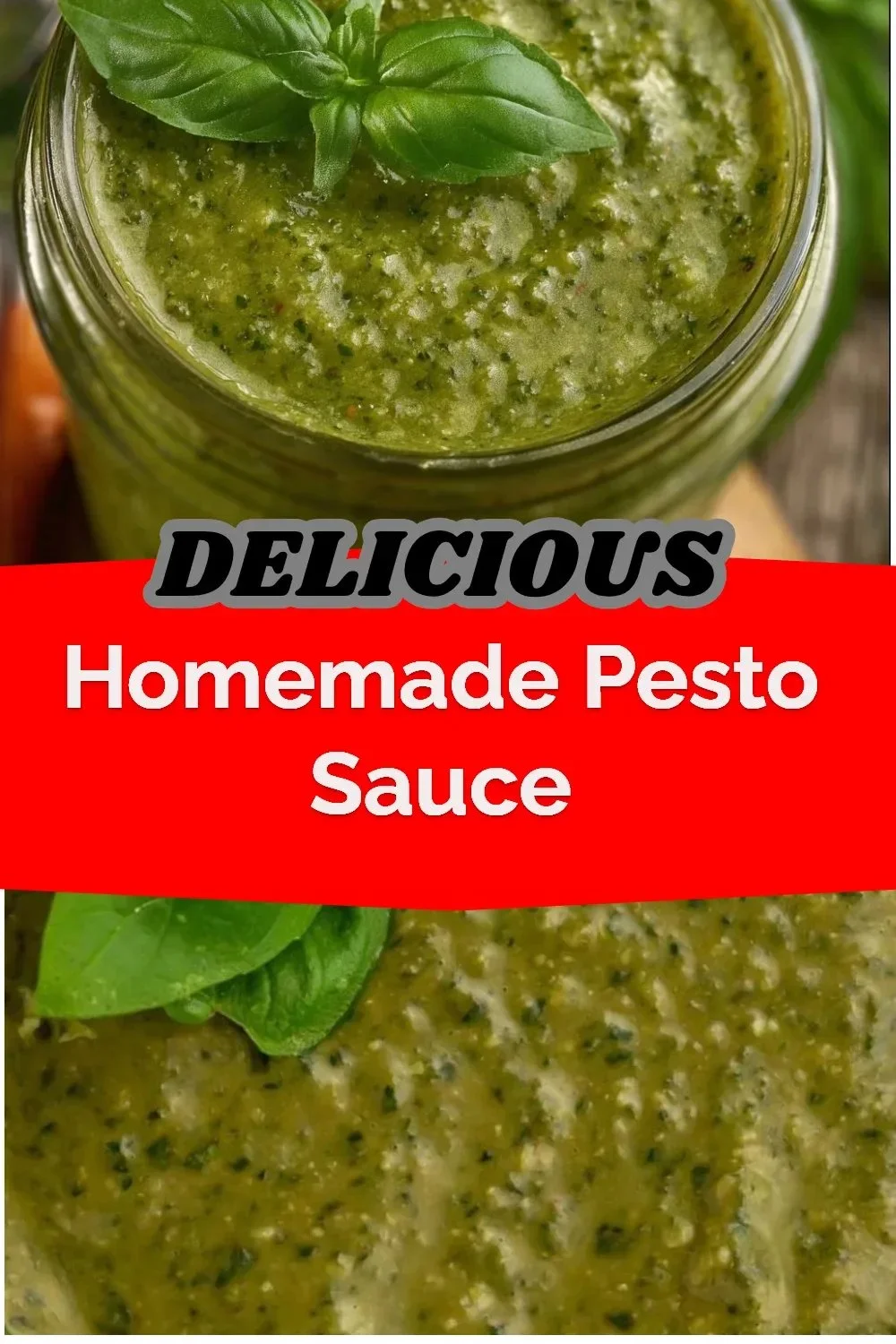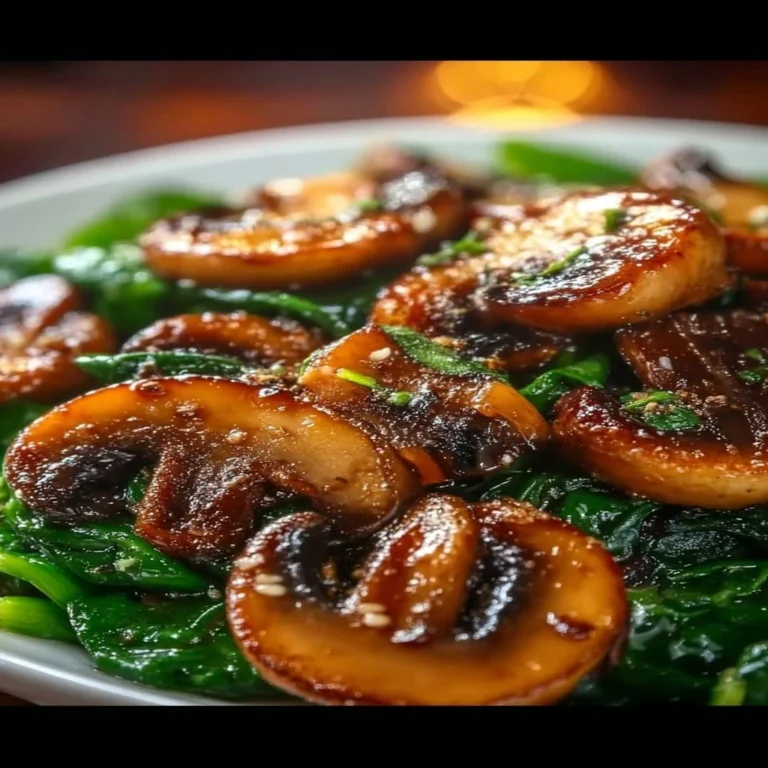Homemade Pesto Sauce
why make this recipe
Homemade pesto sauce is a delightful addition to many dishes. It bursts with fresh flavors, making any meal feel special. By making your own pesto, you can control the ingredients, ensuring quality and freshness. Plus, it’s super easy to whip up! Store-bought versions often lack the vibrant taste and may include preservatives, while homemade pesto is as fresh as it gets. You can use it on pasta, sandwiches, or as a dip, making it one of the most versatile sauces in your kitchen.
The key ingredients like fresh basil, Parmigiano-Reggiano cheese, and pine nuts create a delicious combination that lifts your dishes without overpowering them. You will find that once you make this recipe, it becomes a staple in your cooking routine. It’s perfect for busy weeknights or for impressing guests at a dinner party.
how to make Homemade Pesto Sauce
Making homemade pesto sauce is simple and straightforward. You don’t need to be a culinary expert to create this delicious blend. Let’s walk through the ingredients and step-by-step process.
Ingredients :
- 2 cups fresh basil leaves
- 1/2 cup grated Parmigiano-Reggiano cheese
- 1/2 cup olive oil
- 1/4 cup pine nuts
- 2 cloves garlic
- 1/4 cup heavy cream
- Salt to taste
Directions :
-
Begin by gathering all the ingredients. It’s important to make sure the basil leaves are clean and dry. You don’t want any excess water ruining your pesto.
-
Next, take your food processor and add the fresh basil leaves, the grated Parmigiano-Reggiano cheese, pine nuts, and the cloves of garlic. Pulse the mixture until everything is finely chopped. This blending process releases the oils from the basil and starts building the sauce’s flavor.
-
While the processor is running, slowly drizzle in the olive oil. This step is crucial as it helps emulsify the ingredients, creating a creamy and cohesive sauce. Keep blending until you achieve a smooth texture.
-
Now, add the heavy cream and a pinch of salt. Blend again until everything is well combined. The heavy cream adds richness to the pesto, making it even more delicious.
-
Finally, taste the sauce and adjust the salt if needed. Once you’re satisfied with the flavor and texture, your homemade pesto sauce is ready to serve!
how to serve Homemade Pesto Sauce
Homemade pesto sauce is incredibly versatile. Here are some delicious ways to enjoy it:
-
Pasta: Toss your favorite cooked pasta with a generous spoonful of pesto. The warmth of the pasta will help the sauce cling to every bite.
-
Sandwiches: Spread pesto on sandwiches or wraps for added flavor. It works wonderfully with turkey, chicken, or even a veggie sandwich.
-
Dips: Serve pesto as a dip with fresh veggies or chips. It makes for a delightful appetizer at gatherings.
-
Pizza: Drizzle some pesto over pizza before baking for an extra layer of flavor.
-
Grilled meats: Use pesto as a marinade or topping for grilled chicken, fish, or vegetables.
Feel free to be creative! Pesto can transform almost any dish into something remarkable.
how to store Homemade Pesto Sauce
Storing your homemade pesto sauce is important to maintain its freshness and flavor. Here are some effective storage methods:
-
Refrigerator: To keep your pesto fresh, transfer it into an airtight container. Be sure to cover the surface of the pesto with a layer of olive oil to prevent oxidation. It can be stored in the fridge for up to a week.
-
Freezing: If you want to keep your pesto for longer, consider freezing it. You can pour the pesto into ice cube trays, freeze until solid, and then transfer the cubes to a freezer-safe bag. Individual portions make it easy to grab just what you need later. Frozen pesto can last up to three months.
-
Thawing: When you’re ready to use frozen pesto, just take out a cube or two and let them thaw in the refrigerator, or you can add them directly to warm pasta.
tips to make Homemade Pesto Sauce
-
Use fresh ingredients: The quality of your ingredients makes a huge difference. Fresh basil, quality olive oil, and good cheese create the best flavors.
-
Don’t over-blend: Blending too much can make the pesto watery. Aim for a well-mixed but slightly chunky texture.
-
Experiment with nuts: If pine nuts are expensive or unavailable, try walnuts or almonds for a different flavor profile.
-
Herbs variety: You can mix basil with other herbs like parsley or garlic to vary the taste.
-
Serve it with lemon: Adding a squeeze of fresh lemon juice can brighten the flavors even more.
-
Adjust the cream: If you want a lighter version, you can skip the heavy cream altogether or add less.
variation
If you’re looking to spice things up or use ingredients you have on hand:
-
Nut-free Pesto: Skip the nuts entirely or use sunflower seeds instead for a nut-free option.
-
Vegan Pesto: Replace the cheese with nutritional yeast for a vegan twist.
-
Spinach Pesto: Combine basil with fresh spinach for a different flavor and a boost of nutrients.
-
Roasted Vegetable Pesto: Adding roasted red peppers can give your pesto a sweet, smoky flavor.
FAQs
1. Can I use dried basil instead of fresh basil?
While dried basil can be used in a pinch, it won’t provide the same fresh flavor as fresh basil. The oils and vibrant taste of fresh herbs make a significant difference in this recipe.
2. Can I make pesto without a food processor?
Absolutely! You can finely chop all the ingredients by hand with a sharp knife or mortar and pestle. It will take a bit more time but can be quite enjoyable.
3. How long does homemade pesto last in the fridge?
Homemade pesto will typically last for about one week when stored in the refrigerator in an airtight container.
4. Can I use other cheeses instead of Parmigiano-Reggiano?
Yes, you can substitute with Pecorino Romano or a similar hard cheese. This will slightly change the flavor but remain delicious.
5. What can I do with leftover pesto?
Leftover pesto can be used in many recipes! You can mix it with eggs for a flavorful omelet, spread it on bread for garlic bread, or even add it to soups for a unique twist.
6. Is pesto gluten-free?
Yes, pesto is naturally gluten-free. Just be cautious with the pasta you choose to pair it with if you are serving someone with gluten sensitivities or allergies.
With this simple recipe and guide, you can enjoy the fresh taste of homemade pesto sauce anytime. It’s a wonderful way to add a burst of flavor to your meals. Happy cooking!
PrintHomemade Pesto Sauce
A vibrant and fresh homemade pesto sauce that elevates any dish with its delightful combination of flavors.
- Prep Time: 10 minutes
- Cook Time: 0 minutes
- Total Time: 10 minutes
- Yield: 4 servings 1x
- Category: Sauce
- Method: Blending
- Cuisine: Italian
- Diet: Vegetarian
Ingredients
- 2 cups fresh basil leaves
- 1/2 cup grated Parmigiano-Reggiano cheese
- 1/2 cup olive oil
- 1/4 cup pine nuts
- 2 cloves garlic
- 1/4 cup heavy cream
- Salt to taste
Instructions
- Gather all the ingredients, ensuring the basil leaves are clean and dry.
- Add the fresh basil, grated Parmigiano-Reggiano cheese, pine nuts, and garlic to a food processor and pulse until finely chopped.
- With the processor running, slowly drizzle in the olive oil until emulsified and smooth.
- Mix in the heavy cream and salt, blending until well combined.
- Taste and adjust salt if necessary. Serve immediately or store as needed.
Notes
For longer storage, add a layer of olive oil on top before sealing in an airtight container.
Nutrition
- Serving Size: 1/4 cup
- Calories: 350
- Sugar: 1g
- Sodium: 200mg
- Fat: 36g
- Saturated Fat: 6g
- Unsaturated Fat: 30g
- Trans Fat: 0g
- Carbohydrates: 5g
- Fiber: 0g
- Protein: 6g
- Cholesterol: 15mg








